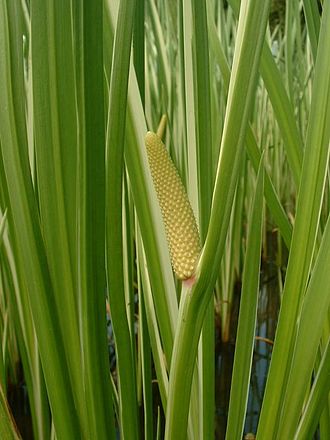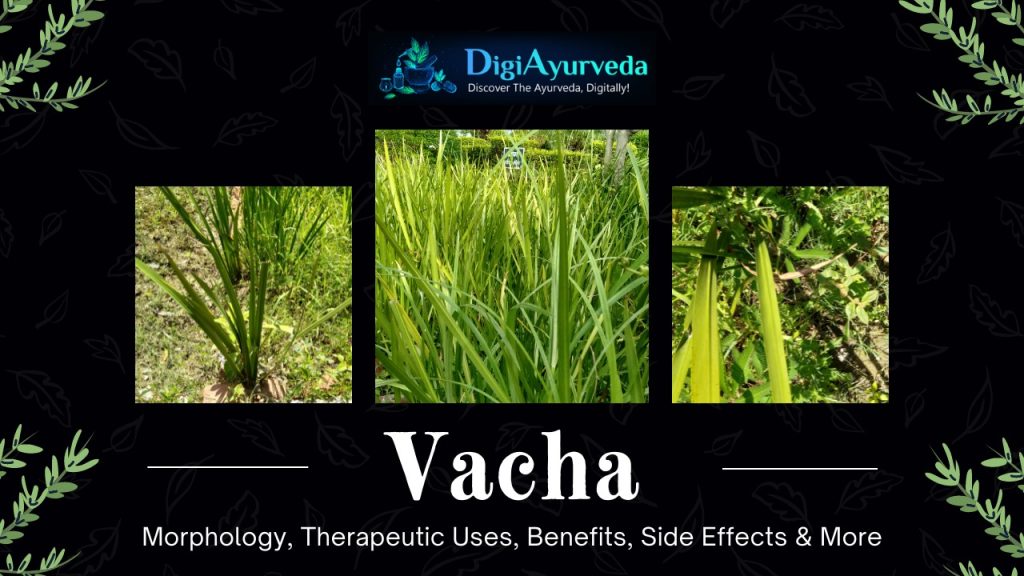
Family : Araceae
Habitat / place of origin
Sweet flag grows in India, central Asia, southern Russia and Siberia, Europe and North America. Habitats include edges of small lakes, ponds and rivers, marshes, swamps, and other wetlands
Biological classification
- Kingdom: Plantae
- Subkingdom: Tracheobionta
- Super division: Spermatophyta
- Division: Magnoliophyta
- Class: Liliopsida
- Subclass: Arecida
- Order: Arales
- Family: Acoraceae
- Genus: Acorus
- Species: Calamus
Introduction To Vacha
Acorus calamus (also called sweet flag, sway or muskrat root, among many common names is a species of flowering plant with psychoactive chemicals. It is a tall wetland monocot of the family Araceae, in the genus Acorus. Although used in traditional medicine over centuries to treat digestive disorders and pain, there is no clinical evidence for its safety or efficacy – and ingested calamus may be toxic – leading to its commercial ban in the United States . It is delineated under various therapeutic groups like Lekhaneeya, Triptighna, Arshoghna dashemani etc. by Acharya Charaka, Pippalyadi, Vachadi etc. ganas by Acharya Sushruta and,Mustadi, Vatsakadi etc. gana by Vagbhata.

Synonyms of Vacha
Sanskrit : Vacha , Ugragandha , Shadgrantha , Golomi , Ugragandh¡, Ugr
Assamese: Boch
English: The Sweet Flag
Gujarati: Ghoduvaj, Ghodvach
Hindi: Bach, Gora-Bach
Kannada: Baje, Narru Berua
Malyalam: Vayambu
Marathi: Vaca, Vekhandas
Punjabi: Varch, Ghodavaca
Tamil : Vasambu, Pillai Maruntho
Telugu Vasa
Unani: Waja-E-Turki
Morphology of Vacha
An aromatic marsh herb, with creeping root-stock.
Leaves : Distichous, base equitant. Peduncle leaf-like
Flower : Green, densely crowded on a cylindric, sessile ,spadix. Sepals, 6;arbicuiar.
Fruit Few seeded berries.
Seeds: oblong
Medicinal Parts
Roots
Plant variety of Vacha
It has four varieties:
- Vacha(ghodvach)
- Parshikvacha (balvach): it has more three varieties :rakt , sweat , neel . Botanical name is iris germanica .
- Maha bharivacha — alpinia galanga
- Davipantarvacha (chopchini )– smilax china linn
OTHER VARIETIES
- Paris polyphylla
- versiolor
- nepalensis
- ensata
- I. kumaonensis
Chemical Composition of Vacha
- Α-Asarone GC-FID, GC-MS Rhizomes/n-hexane, aqueous, methanol, ethanol
- Β-Asarone
- Γ-Asarone
- Eugenyl acetate GC-MS Rhizomes/aqueous extract
- Eugenol
- Isoeugenol
- Methyl eugenol Rhizomes/n-hexane,
- Ethyl acetate
- Methyl isoeugenol Rhizomes/hexane
- Calamol Rhizomes/aqueous extract
- Azulene
- Eugenol methyl ether
- Dipentene
- Asaronaldehyde
- Terpinolene
- 1,8-cineole
- (E)-isoeugenol acetate GC-FID, GC-MS
- (E)-methyl isoeugenol
- Cis-methyl isoeugenol Rhizomes/n-hexane, ethyl acetate
- Euasaron
- Cinnamaldehyde
- Cyclohexanone GC-MS Rhizomes/hexane
- Volatile Oil (principal constituents of the Volatile oil are Eugenol Isoamyl alcohol, and Asarone), also contains a bitter
- Acorin (Glucoside), Starch and Tannin.
Ayurvedic Properties of Vacha
Rasa (Taste) : Katu , Tikta
Guna (Quality) : Laghu , Tikshna
Virya (Potency) : Ushna
Vipak (Post Digestive Effect): Katu
Parbhav (Effect): Medhaya
Karma (Pharmacological Actions)
Dosha Karma : Kapha-Vata Shamak and Pitta Vardhak
Sansthanik Karma (General Indication ): Shothahar , Vednasathapan
Nadisansthan (Cns ): Medhaya , Shamak , Sangyansathapan, Akshepashaman , Vednasathapan
Pachan Sansthan (Digestive System ): Deepan , Triptighan , Arshoghan , Krimighan , Shoolparshaman , Vamak , Anuloman ,
Raktvahsansthan (Cvs): Raktbhar Shamak
Sawasansthan (Respiratory System ): Kapha-Swashar , Kanthaya
Mutravahsansthan (Urinary System ): Mutrajanana
Prajanana Sansthan (Reproductive System ): Garbhashaya Sankochak
Twacha (Skin ): Swedjana
Tapkarma (Thermoregulations ): Jawarghan
Lekhan
Qualities/Effects on Tridosha of Vacha
Due to its katu and ushna it reduces the vata and kapha and increases the pitta dosha.
Formulations of Vacha
- Saraswat churna
- Medhaya rasayan
- Vacha lahsunadi Taila
- Vachadi Taila,
- Saraswatarishta
- Manasmitra Vataka,
- ChandraPrabha Vati
- Khadiradi Vati
- Hinguvachadi Churna
Therapeutic Uses of Vacha
- It is indicated in all kapha and vata diseases.
- It is indicated in neurological disorders.
- It is indicated in ear pain.
- It is indicated in epilepsy and seizures.
- It is indicated in digestive system disorders.
- It is indicated for inducing vomiting.
- It is indicated in respiratory disorders like rhinitis , cough , cold , etc.
- It is indicated in calculi and dysuria.
- It is indicated in obstetric labour.
- It is indicated in dysmenorrhea.
- It is indicated in obesity.
- It is indicated for memory enhancer.
- It is indicated in fever.
- It is indicated in Postpartum depression.
- It is indicated in Delayed speech and language milestones in children.
- It is indicated in Asthma , Common cold or Flu.
- It is indicated in Worm infestation – intestinal worms.
- Irritable bowel syndrome.
Dosage
- Therapeutic Dose: 125 – 500 mg
- vamanarth= 1-2gm
How can you consume Vacha?
It is used as in form of powder and with honey . It is used with different formulations.
Benefits of Vacha
- Vacha main increase the appetite.
- It helps to control the gastric secretion does help in controlling acidity. It can also protect the inner lining of the stomach from the bacteria thus reduces the ulcer.
- Helicobacter pylori and prevents damage.
- Increases digestive fire , This helps to digest the food easily and also controls excessive secretion of gastric juice.
- Colic pain and diarrhea.
- Diarrhea, Flatulence (gas formation), Stomach ulcers, Strok.
- Vacha helps in glowing of skin or increase the complexion of the skin and control various bacterial and fungal skin infections.
- Helps in wound healing.
- Useful in reducing pain and swelling when applied externally on the affected area.
- Vacha helps to lower the associated arthritis symptoms like it lowers the pain and swelling.
- Vacha might help manage anxiety, depression and stress due to its Medhaya (memory enhancing) property.
- Vacha might help in managing speech disorders.
- It provide a sufficient strength to the body with sufficient stand to control the nerve related disorders.
- It has to clearing the air passage by removing the mucus from it so helps to provide relief from the cough thus helps in the management of cough.
- It improves the mental performance and memory as well as the it improves the behavioural changes.
- Help to remove urinary stones.
- It helps in dilation of lungs airways does help to manage asthma.
- Help in Coryza.
- It’s stop the spread of infection like it prevent the replication of herpes virus type 1 and type 2.
- Used commonly for toothache.
- Might be used in managing headaches.
- Reduce the symptoms of Jamalgota toxicity.
Side Effects of Vacha
It shows following side effects:
- Upset stomach
- Shaking
- Seizures
- Kidney damage
- High dose of WhatsApp for long duration is not advised.
- In pittaj Prakriti persons Vacha should be avoided .
- Vacha in pittaj Prakriti and in pitta dominant conditions it may causes headache.
Safety Precautions of Vacha
- When it combined with medicine used during surgeries it may cause excessive sleeping as because it act on the central nervous system.Therefore, it is advised that use of Vacha should be stop before 2 weeks of surgery.
- It should be used under prescribed those and for prescribe duration by the doctor
- Allergic persons or hypertensive patient use vacha under doctor’s supervision .
- Avoid Vacha if you are breastfeeding
- It increase gastric acid secretion and it may surprises the effect of antacids. So avoid the use of vacha in with the antacids
- It may have antidepressant effect .
- It might cause sleepiness and drowsiness. Therefore, its use should not be used with other sedatives
- Vacha should be used with prescription in cancer patients or patients who are taking antineoplastic agents
- It is calcium channel blockers so it may increase the risk of constipation.
- It may lower blood pressure. So it is advised to monitor your blood pressure regularly while taking Vacha along with other anti-hypertensive drugs
- Avoid Vacha during pregnancy
Substitutes & Adulterants
Adulteration:
- Inula racemosa
- Iris germanica
References & Further Reading
- DRAVYAGUNA VIGYAN =PV SHARMA
- https://www.1mg.com/ayurveda/vacha-22
- THE AYURVEDIC PHARMACOPOEIA OF INDIA PART- I VOLUME – II




